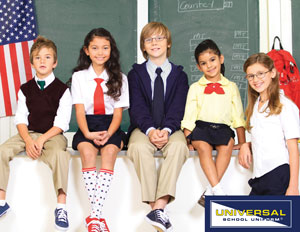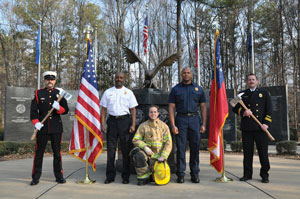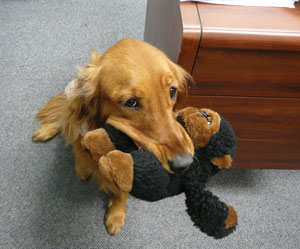
[one_half][dropcap style=”font-size: 60px; color: #26738c;”]T[/dropcap]he uniforms students wear now are pretty similar to the uniforms students have worn for generations. Nevertheless, school uniform companies have had to work hard to keep up with the times and changes in a business that used to be considered a sure thing. Some firms combine school uniform accounts with others to survive, while others companies have kept them as the bulk of what they handle. Recently Made to Measure spoke with several companies in the school uniform market to learn more about their experiences.
One of the Few Manufacturers Left
The Singer family has been producing apparel uniforms in this industry for 75 years. “I think that’s pretty significant,” says Maurina Billere, account manager, handling the promotional products for Executive Apparel in Philadelphia, “We’ve been a stable, growing company, and we’ve seen a lot of changes in uniforms, experiencing the growth process too.”
Executive Apparel has been a unifying force in the uniform market, according to Billere, because it handles education, hospitality, transportation and security. The education segment includes colleges, charter schools and Greek Life.
There have been three generations of Singers involved with the company and the school uniform market. Real craftsmen have been involved with the development of this family-owned business, according to Billere. “These guys grew up eating, sleeping and drinking suits, career apparel and uniform apparel, creating a nice mix – the meeting of tradition and at the same time answering a lot of corporate needs.”
“We’re basically those who come from the manufacturing side of the business, and our specialty is tailored clothing. That’s what we do,” explains Donald Singer, president, who is the third generation in his family to be involved with running Executive Apparel.
His father made leather garments for the Philadelphia Police Department. That was also what his grandfather did when he first started in business. A major seller was a fur-lined double-breasted topcoat designed to keep the police warm in the wintertime. Singer says, “We still have 15 to 20 employees here in our Philadelphia plant.”
Education uniforms and the apparel associated with schools form a significant portion of Executive Apparel’s blazers. “If a school needs uniforms, they’re not going to call us directly; they’re going to call up Flynn and O’Hara or Parker Uniforms, all of whom we supply to,” says Billere.
School uniforms make up 25 to 30 percent of Executive Apparel’s business. The rest of its business is either custom or stock programs; it also does production management for various customers.
Executive’s Elite Schoolwear label is made with quality fabrics, like its traditional Ultralux Polyester and the soft and warm 100 percent wool flannels. The label includes blazers, shirts, blouses, skirts and “the best-fitting bottoms on the planet, from our casual pants to our stylish shorts and skorts,” according to Billere. “They are worn by students in private, parochial and charter schools throughout the country.”
Going from Fashion to Function
Caplan’s has been in Alexandria, La., since 1891 when David Caplan, who immigrated from central Europe, opened a store and sold farmer’s overalls, work uniforms, accessories and eventually other clothing for men and boys. “Our company has been here for 120 years,” explains Norrine Caplan, company secretary and treasurer, who is married to David’s grandson, also named David Caplan.
“There was a time not long ago when I would have told you our main business was fashion,” says Caplan. “After family members analyzed the business, they decided it was time to focus on the uniform business exclusively. We often hear from our customers and friends that they miss our fashion store, but we are very happy we consolidated into the uniform business. We decided to take something that we think we did well and really concentrate on it. We are now somewhat dominant in our trade area, which has a population of about 400,000 people.”
Caplan’s biggest customers are companies and municipalities that purchase logoed wearables. It sells polo shirts to anyone, from car companies to local fast-food franchises and hotels to restaurants. Shortly after deciding to focus on the uniform business, the Catholic school diocese approached Caplan’s to enter school uniform segment to serve the 1,200 to 1,300 schoolchildren who attend four private schools. They buy their clothes exclusively from Caplan’s.
School uniform traffic is highly concentrated in the later summer months during the few weeks before school starts. According to Caplan, the ability to handle the huge rush and still offer good customer service was one of the reasons the diocese approached Caplan’s specifically.
She says, “When we decided to get into this business we heard from other similar businesses that we should charge for everything. Every time we put a hem in, we should charge; every time we let a hem out, we should charge. Well, we just don’t do that. We do the tailoring but we don’t charge. We have a tailor shop in our store, and our people do a great job.”
One of Caplan’s customers is a high school. Caplan tries to employ a current or recently-graduated student from that school because he or she will know the dress code and the students, so it makes for a good match. The company also enjoys giving people their first job.
Caplan adds, “It is very important to us to keep everyone happy; even if we have to take back a shirt or a pair of pants we might have little or no hope of selling. It is impossible to measure goodwill in dollars and cents. Word of mouth is important in every business; it certainly is true in this business.”
Caplan says she is satisfied with the store’s vendors, who make consistent, high-quality garments. It is a quality she carefully considers before pairing her store’s name with the vendor’s name. She says, “We have a good partnership with our vendors. Consistency is very important to our customers. This is quite a change from the fashion business where the newest trend could leave the retailer with a mountain of obsolete merchandise”
Business in a High Cost of Living Region
Bancroft Uniforms of San Leandro, Calif., supplies school uniforms for students from pre-school through high school. All of its uniforms are made in the U.S. It has been in its current location for about 83 years. The business was originally, Bancroft Menswear.
Service has been the key to its longevity, according to Bruce Barnes, owner. It contracts directly through the schools and has a store in the Bay Area city of San Leandro where customers can come to shop directly for school uniforms. In this high cost of living area, Bancroft Uniforms has the distinct advantage of being the owner of its own building and other properties.
Employees also go to schools and set up a complete store in the schools to sell uniforms. This has gone on for the past 15 years. “We have a 26-foot trailer that we take to the schools containing 200 bins that we roll out and set up, including dressing rooms,” says Barnes. Their service area stretches from Redding down to Bakersfield. It includes some 90 schools.
“With the recession, classrooms and schools have been shutting down. In our area they’ve shut a lot of the Catholic schools down. There are now fewer students in the private school classrooms,” Barnes says. “You look at other entities, like charter schools, to pick up where the private schools are disappearing. Though changing from private schools to charter schools has been challenging, the enrollments in some schools are starting to rise, which means we are just starting to see the market return back to normal again.”
The charter schools Bancroft Uniforms deals with have uniforms and can make it mandatory. That’s an option public schools don’t have. “We’re doing a couple of public schools, but you can’t really get a contract with them,” he says. Most school contracts state that any uniform problems will be worked out between Bancroft and the school principal and resolved in a way that will make everybody happy, according to Barnes.
During the regular school year Bancroft has between six and eight employees, but in the summer it has 24. Its prices are competitive with other uniform schools out there. Inventory is tracked with Retail Pro, a computer program. The store has 16,000 line items and 65,204 units. There’s been no need to revamp its program so it’s stayed the same over the years.
“We’re looking for growth happening this year, sales increasing and more spending. But if something happens with the economy, that all can change. There really are no guarantees like we used to think. The way we do business, people seem to be happy with us. Satisfaction from either the internet or from letters that we receive has all been very, very high,” says Barnes.
Satisfying the Customer
A+ Career Apparel is a direct-to-the-customer apparel manufacturer. Dealing directly with a manufacturer allows customers to eliminate the pass-through costs from traditional distributors. A+ Career Apparel designs, builds, stocks, embroiders and ships directly to customers.
“No middle man means significant cost savings,” says Vince Knoss, A+ marketing director. “From tops to bottoms, we manufacture everything, including a wide variety of jackets, sweaters, vests, shirts, poplin and oxford button downs, polos, plain and pleated men’s and women’s pants and shorts, cargo pants and shorts, active-wear, socks, aprons and much, much more. A+ has over $20 million of inventory currently in stock on our shelves and available for immediate delivery.”
Its A+ School Apparel division also offers a full line of in-stock school uniforms and dress code apparel in a variety of youth and adult sizing, styles and colors. The primary manufacturing facility, warehouse and distribution center are located in Star City, Ark., in the heart of the U.S. markets. A+ also has offshore facilities and sourcing capabilities.
“Our offshore manufacturing is done in Mexico, Dominican Republic and Thailand,” says Knoss. “We like to consider ourselves a one-stop shop and solution for the custom apparel needs of our customers. Our various avenues of manufacturing, distribution and direct sourcing have increased our customers’ profitable sales, growth and continued success.”
He says, “Having a very friendly, knowledgeable and well-trained person on the other end of the line is the key to any business’s success. We will work together to get you what you need, when you need it. That’s our promise. That’s the A+ culture we live by, and we try to make that the case whenever we do business – that, along with engaging people and encouraging them to join our A+ community and becoming a ‘fan’ of A+ Careerwear and A+ Schoolwear on Facebook.”
From the Top Down
Tracy Tanidjaja, owner and vice president with Stani Corp. in Ontario, Calif., wholesales to the entire U.S. plus Canada, Bahamas and the Virgin Islands. Supplying polo shirts, pants, shorts, skirts, skorts, jumpers, cardigans, vests and jackets to schools is perhaps the mainstay of their business as they carry some 17 different colors of polo shirts. Though their prices aren’t the cheapest, Tanidjaja feels the quality of their products is what sets them apart.
“Everyone also needs to have good service too, which we provide,” says Tanidjaja. “But we also have something called open stock which allows us to function without pre-packs, meaning we can order any size. We don’t have to use the four sizes coming in the box. Our sales are to wholesalers and to distributors that go to schools, get the bid and then buy from us.”
Stani Corp. does private labels in addition to doing its own brand called Universal School Uniforms. In its polo shirts, the company has a wide variety of sizes and colors, in addition to girls’ polo shirts.
Public schools are its mainstay now, largely resulting from something President Bill Clinton did back in 1996. In the wake of intense rivalries for designer clothes in schools including some violence, Clinton, in the name of putting “discipline and learning back in our schools,” had the U.S. Department of Education distribute manuals to 16,000 school districts across the country explaining how they could legally enforce school uniform programs.
“Public schools, state by state, started to join this effort,” says Tanidjaja. “From then on, each year another state would join. Texas started in one county or school district, others across the state saw their success and joined, and then Tennessee and Louisiana joined. California last year saw more and more counties and school districts start. Whenever you think uniforms, you think private schools. But this was public schools and often the item worn wasn’t as important as the colors, say blue and white if those were that school’s colors; there’s much more flexibility in public schools with uniforms.”
Stani Corp. doesn’t approach the schools but sells to the wholesalers and those who bid on a contract. In a meeting, they will provide a sample to show the school. “Everyone, all the brand names, are now going into uniforms,” says Tanidjaja. “But the schools don’t want the brand name logos. We are doing well, as long as we maintain our quality. Quality is the key.”
Tanidjaja shares a specific story of one customer. “One of our customers was involved in a news story involving a comparison of three outlets: a high-end store, a dollar-type store and clothes items from Stani Corp. After five washings in a coin-operated machine, the Stani item held out the best. Customers want a good price for a good quality because they are wearing it every day.”![]() [/one_half]
[/one_half]
[one_half_last]




 [/one_half_last]
[/one_half_last]













